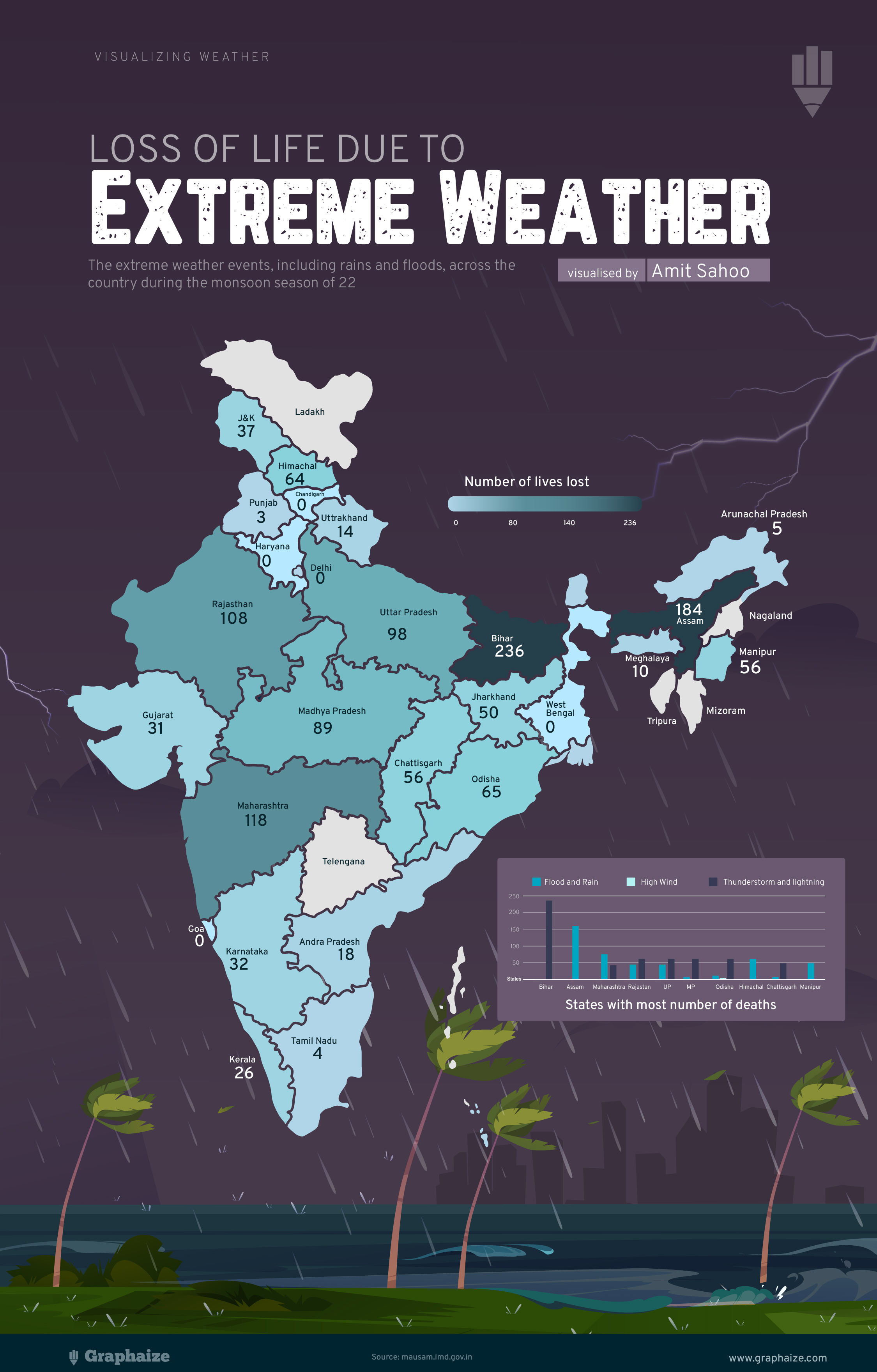Extreme Weather in India: Visualizing Life Loss Statistics
 Graphaize Marketing
Graphaize Marketing
India, with its diverse climate and vast geographical expanse, is increasingly bearing the brunt of extreme weather conditions. In recent years, the frequency and intensity of these extreme events have surged, driven in part by climate change. This escalating pattern has had a dire impact on human life, with thousands losing their lives annually due to natural disasters like floods, droughts, and storms.
According to the National Disaster Management Authority (NDMA), over 1304 people lost their lives in 2022 alone due to natural calamities, marking a sharp rise from previous years. Cyclones, such as Cyclone Fani and Cyclone Amphan, have wreaked havoc along the eastern coast, displacing millions and causing numerous fatalities.
Floods remain a perennial threat, with states like Assam, Bihar, and Kerala witnessing devastating inundations. In 2022, floods claimed over 605 lives, as per the Indian Meteorological Department (IMD). We created this infographic that explores the stark increase in weather-related fatalities in India focusing on the most vulnerable regions.
Agriculture and the danger of lightning
Agriculture is one of the most vulnerable occupations when it comes to extreme weather, particularly lightning. Farmers and agricultural workers often spend long hours outdoors, increasing their risk of lightning strikes. According to the National Weather Service Lightning Fatalities of India, lightning accounted for over 53.2% of all deaths caused by natural disasters in 2022, with a significant proportion of victims being farmers.
In 2022, Bihar experienced notably high death rates due to thunderstorms and lightning, with 236 fatalities. Madhya Pradesh and UP are among other states with high amounts of deaths due to lightning. Several factors contribute to this alarming trend. These states are geographically prone to severe thunderstorms and lightning, especially during the pre-monsoon and monsoon seasons. Bihar particularly experiences intense storms that bring heavy rainfall, strong winds, and frequent lightning strikes. As a significant portion of the population relies on agriculture, requiring them to work outdoors, this increases their exposure to lightning strikes, as they often lack safe shelters during sudden storms.
Additionally, there is a lack of widespread awareness and education about lightning safety in rural areas. Many people are unaware of the necessary precautions to take during thunderstorms, such as avoiding open fields, seeking proper shelter, and staying away from trees and tall objects. Moreover, infrastructure in rural regions is often inadequate. The absence of lightning rods and other protective measures in homes and public buildings leaves people vulnerable.
Combining geographical vulnerability, occupational exposure, lack of awareness, inadequate infrastructure, and insufficient emergency response contribute to the high death rates from thunderstorms and lightning in Bihar and Madhya Pradesh.
Preparedness and reducing deaths from Cyclones
The Super Cyclone of 1999 was a catastrophic event that devastated Odisha, India. With wind speeds exceeding 260 km/h and a storm surge up to 7 meters high, it caused unprecedented destruction. Over 10,000 people lost their lives, and millions were left homeless. The cyclone destroyed infrastructure, agriculture, and livestock, leading to severe economic losses and long-term hardship for the affected communities.
In recent years, Odisha has made significant strides in cyclone preparedness and disaster management. By 2022, the state had implemented several measures to mitigate the impact of cyclones. These included the construction of robust cyclone shelters and embankments, improving early warning systems, and conducting regular community awareness and preparedness programs. The Odisha State Disaster Management Authority (OSDMA) has played a crucial role in coordinating these efforts.
The state has also invested in modern technology for real-time weather monitoring and forecasting, ensuring timely and accurate warnings. During cyclones, efficient evacuation plans and pre-positioning of relief materials have significantly reduced casualties and damage. The state’s proactive approach and community involvement have transformed Odisha into a model for disaster resilience, showcasing how effective planning and preparedness can mitigate the impact of natural disasters. The initiatives have become a case study for the other states and improved preparedness which reduced the deaths from extreme cyclones.
Climate Change and Extreme Weather
Climate change significantly contributes to extreme weather events, leading to increased floods, heavy rains, high winds, thunderstorms, and lightning. In 2022, these phenomena had a profound impact on Indian states.
Rising global temperatures cause more evaporation, leading to increased moisture in the atmosphere. This results in heavier and more unpredictable rainfall, often causing flash floods. Indian states like Assam and Bihar experienced severe floods due to excessive monsoon rains exacerbated by climate change.
Additionally, warming oceans contribute to the intensity of cyclones and storms. Higher sea surface temperatures provide more energy for storms, leading to stronger winds and increased rainfall. Coastal states like Odisha and West Bengal faced more intense cyclones, with destructive high winds and storm surges.
Subscribe to my newsletter
Read articles from Graphaize Marketing directly inside your inbox. Subscribe to the newsletter, and don't miss out.
Written by
